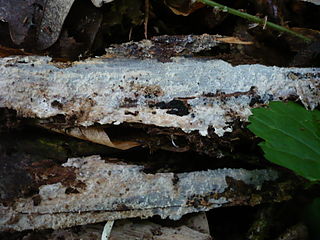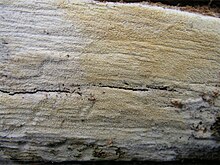Abundisporus is a small genus of poroid fungi currently with seven recognized species. They differ from other polypores in having coloured rather than hyaline spores.

Phanerochaete is a genus of crust fungi in the family Phanerochaetaceae.

The Phanerochaetaceae are a family of mostly crust fungi in the order Polyporales.

The Steccherinaceae are a family of about 200 species of fungi in the order Polyporales. It includes crust-like, toothed, and poroid species that cause a white rot in dead wood.

Erast Parmasto was a noted Estonian mycologist, bioscientist and botanist and onetime director of the Estonian Institute of Zoology and Botany.

The Botryobasidiaceae are a family of fungi in the order Cantharellales. The family contains a group of corticioid fungi that form thin, web-like basidiocarps. Some species form asexual anamorphs producing chlamydospores. All are believed to be wood-rotting or litter-rotting saprotrophs. None is known to be of any economic importance.

Byssomerulius is a widely distributed genus of crust fungi.

Trichaptum is a genus of poroid fungi. The genus was circumscribed by American mycologist William Alphonso Murrill in 1904. Formerly classified in the family Polyporaceae, several molecular studies have shown that the genus belongs to the order Hymenochaetales.

Resinicium is a genus of crust fungi of uncertain placement in the class Agaricomycetes. The genus was circumscribed by Estonian mycologist Erast Parmasto in 1968.

Phlebia is a genus of mostly crust fungi in the family Meruliaceae. The genus has a widespread distribution. Phlebia species cause white rot.

Scytinostromella is a genus of crust fungi in the Stereaceae family. The widespread genus contains five species. The genus was circumscribed by Estonian mycologist Erast Parmasto in 1968, who set Peniophora heterogenea as the type species. Characteristic features of the genus include dimitic hyphae, spores that are both amyloid and asperulate, and the presence of cystidia and rhizomorphic strands.
Gilbertsonia is a fungal genus in the family Fomitopsidaceae. This is a monotypic genus, containing the single brown rot species Gilbertsonia angulipora, found in the United States. Gilbertsonia is characterized by a dimitic hyphal system with clamped generative and well-developed binding hyphae. The generic name honors mycologist Robert Lee Gilbertson.

Dentocorticium is a genus of six species of poroid fungi in the family Polyporaceae. The genus was revised in 2018, with several new species added and some older species transferred to other genera, based on phylogenetic analyses.
Dictyonema is a genus of mainly tropical basidiolichens in the family Hygrophoraceae.

Fibrodontia is a genus of fungi in the Hydnodontaceae family. The widely distributed genus was circumscribed by Erast Parmasto in 1968. According to Index Fungorum, the type species Fibrodontia gossypina is currently known as Hyphodontia gossypina (Parmasto) Hjortstam.
Bondarcevomyces is a genus of fungus in the Tapinellaceae family. It is a monotypic genus, containing the single species Bondarcevomyces taxi, found in Asia. The species was originally described as Polyporus taxi by Appolinaris Semyonovich Bondartsev in 1940, and was transferred to the genera Hapalopilus, Tyromyces, and Parmastomyces before being made the type of the newly created Bondarcevomyces, published in Mycotaxon Vol.70 on page 219 in 1999.

Fibroporia is a genus of ten species of poroid crust fungi in the family Fomitopsidaceae. The genus contains species similar to those in genus Antrodia, but they are phylogenetically distinct.
Lilaceophlebia is a genus of three species of crust fungi in the family Meruliaceae. The genus was first proposed by Erast Parmasto in 1968 as a section of the genus Phlebia. Viacheslav Spirin and Ivan Zmitrovich elevated the taxon to generic status in 2004.
Acanthophysellum is a genus of fungus belonging to the family Stereaceae.
Atheloderma is a genus of fungi belonging to the family Rickenellaceae.












